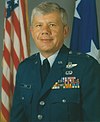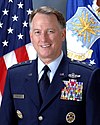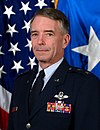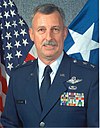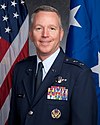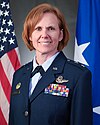Tenth Air Force
| Tenth Air Force | |
|---|---|
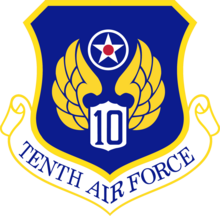 Shield of the Tenth Air Force | |
| Active | 1 December 1985 – present (as Tenth Air Force) 8 October 1976 – 1 December 1985 (as Tenth Air Force (Reserve)) 20 January 1966 – 31 December 1969 24 May 1946 – 1 September 1960 18 September 1942 – 6 January 1946 (as Tenth Air Force) 4 February 1942 – 18 September 1942 (as 10 Air Force) (82 years, 11 months)[1] |
| Country | |
| Branch | |
| Type | Numbered Air Force |
| Role | Provide combat-ready reserve air forces to Air Combat Command, Air Force Global Strike Command, Pacific Air Forces, Air Education and Training Command, Air Force Special Operations Command, and Air Force Space Command |
| Part of | |
| Headquarters | Carswell Air Reserve Station, Naval Air Station Joint Reserve Base Fort Worth, Texas, U.S.[1] |
| Engagements | World War II - Asiatic-Pacific Theater |
| Decorations | Air Force Outstanding Unit Award |
| Commanders | |
| Commanding officer | Maj Gen Regina A. Sabric |
| Command chief | CMSgt Christopher S. Bluto Jr. |
| Notable commanders | Lewis H. Brereton Clayton L. Bissell Howard C. Davidson |
The Tenth Air Force (10 AF) is a unit of the U.S. Air Force, specifically a numbered air force of the Air Force Reserve Command (AFRC). 10 AF is headquartered at Naval Air Station Fort Worth Joint Reserve Base/Carswell Field (formerly Carswell AFB), Texas.
The command directs the activities of 14,000 Air Force Reservists and 950 civilians located at 30 military installations throughout the United States. 10 AF is the AFRC numbered air force whose units and aircraft are primarily gained by the Combat Air Forces (CAF), specifically Air Combat Command (ACC), with a smaller number also gained by Air Force Global Strike Command (AFGSC), Pacific Air Forces (PACAF), Air Force Special Operations Command (AFSOC) and Air Education and Training Command (AETC). In addition, Tenth Air Force units fly satellites for Air Force Space Command (AFSPC) in support of the Department of Defense and NOAA.
Tenth Air Force was a United States Army Air Forces combat air force created for operations in India, Burma and Indochina during World War II in the China Burma India Theater of operations. It was established at New Delhi, India, on 12 February 1942, around a nucleus of air force personnel newly arrived from Java and the Philippines, under the command of Major General (later Lieutenant General) Louis Brereton. In the years since World War II, the 10th Air Force has served both US air defense under the former Air Defense Command and Aerospace Defense Command, and reserve training and readiness programs under the cognizance of the Air Force Reserve (AFRES) and the Air Force Reserve Command (AFRC).
The 10th Air Force is commanded by Maj Gen Regina A. Sabric.
Overview
[edit]Tenth Air Force, located at Naval Air Station Fort Worth Joint Reserve Base, Texas, directs the activities of nearly 16,000 reservists and 636 civilians located at 31 military installations throughout the United States. The mission of Tenth Air Force is to exercise command supervision of its assigned Reserve units to ensure they maintain the highest combat capability to augment active forces in support of national objectives.
With approximately 60 full-time headquarters staff members, Tenth Air Force acts as the focal point for all matters pertaining to assigned Air Force Reserve units and individuals. With the assistance of 36 traditional reservists assigned, the headquarters monitors and provides assistance to all subordinate units to help resolve problem areas and more efficiently maintain unit combat readiness.
The headquarters is responsible for managing and supervising five fighter wings comprising eleven fighter squadrons and seven fighter groups; one rescue wing comprising six air rescue squadrons in two groups; one bomb wing; one airborne warning and control group; one special operations wing; one space wing comprising nine squadrons; one regional support group; and more than seventy non-flying units.
If mobilized, the flying units with custody of their own aircraft and their support elements would be gained by Air Combat Command (ACC), Air Force Special Operations Command (AFSOC), and Air Force Global Strike Command (AFGSC), with other units gained by Air Force Space Command (AFSPC), Air Education and Training Command (AETC), Air Mobility Command (AMC), United States Air Forces in Europe (USAFE) and Pacific Air Forces (PACAF). Tenth Air Force is the only Numbered Air Force that touches every Major Command in USAF with the exception of the Air Force Materiel Command (AFMC).
The flying organizations within Tenth Air Force include fighter units equipped with the F-16 Fighting Falcon and A-10 Thunderbolt II; air rescue units equipped with the HC-130 Hercules and the HH-60 Pave Hawk helicopter; a bomb wing equipped with the B-52 Stratofortress; a special operations unit equipped with the C-145A Skytruck and the U-28; fighter associate program groups embedded with active duty USAF wings and equipped with the F-22 Raptor, F-15E Strike Eagle and F-16 Fighting Falcon; an airborne warning and control associate unit equipped with the E-3 Sentry; and associate units flying MQ-1 Predator, MQ-9 Reaper and RQ-4 Global Hawk Unmanned Aerial Vehicles. The 610th Regional Support Group at NAS Fort Worth JRB is responsible for the management of twelve geographically separated units throughout the United States.
Other organizations include combat air operations, medical, civil engineer, combat logistics, communications, security forces, aerial port, intelligence and aeromedical units. Additionally, the Reserve portion of the Air National Guard/Air Force Reserve Test Center (AATC), which conducts operational test and evaluation of fighter equipment and improvements, is directly assigned to Tenth Air Force.
Reservists from 10th Air Force units are routinely deployed to Air Expeditionary units in combat areas of Central and Southwest Asia as part of the Overseas Contingency Operation.
Units
[edit]Operational units of Tenth Air Force are:[2]
- Combat Air Forces
- 44th Fighter Group - Tyndall AFB, Florida
- 301st Fighter Wing – NAS JRB Fort Worth, Texas
- 307th Bomb Wing – Barksdale AFB, Louisiana
- 414th Fighter Group – Seymour Johnson AFB, North Carolina
- 419th Fighter Wing – Hill AFB, Utah
- 442d Fighter Wing – Whiteman AFB, Missouri
- 477th Fighter Group – Elmendorf AFB, Alaska
- 482d Fighter Wing – Homestead ARB, Florida
- 919th Special Operations Wing – Eglin AFB Aux Field No. 3 / Duke Field, Florida
- 920th Rescue Wing – Patrick Space Force Base, Florida
- 924th Fighter Group - Davis-Monthan AFB, Arizona
- 926th Wing – Nellis AFB, Nevada and Creech AFB, Nevada
- 943d Rescue Group – Davis-Monthan AFB, Arizona
- 655th ISR Group - Wright-Patterson AFB, Ohio
- Regional Support Groups
- Space Forces
- 310th Space Wing – Schriever AFB, Colorado
- Pilot Training Forces
- 944th Fighter Wing – Luke AFB, Arizona
- Command/Control Forces
- 513th Air Control Group – Tinker AFB, Oklahoma
Tenth Air Force Squadrons, Flights, and Operational Locations are also stationed at:
|
|
History
[edit]World War II
[edit]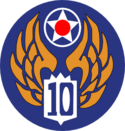
Tenth Air Force was constituted on 4 February 1942 and activated on 12 February, built up around a nucleus of air force personnel newly arrived from Java and the Philippines, under the command of Maj. Gen. Lewis H. Brereton. It had its headquarters at New Delhi. Components of the air force moved to India over a three-month period from March to May 1942. It was responsible for creating, operating and safeguarding the India-China Ferry, more commonly known as the Hump airlift, between 8 April and 1 December 1942, first with its Assam-Burma-China Command until 16 July, then the India-China Ferry Command until 1 December, when jurisdiction for the airlift passed to the Air Transport Command.
The Tenth Air Force initially provided control of all USAAF combat operations in the China Burma India Theater under theater commander Lt. Gen. Joseph Stilwell.
Under General Clayton Bissell's re-organization of the Tenth Air Force, five commanders reported to him: Brigadier General Caleb V. Haynes ran the India Air Task Force, created 8 October 1942, Brig. Gen. Claire Chennault ran the China Air Task Force, created 4 July 1942 to replace the American Volunteer Group, Robert F. Tate ran the India–China Ferry Command, Robert C. Oliver ran the Tenth's service arm and Francis M. Brady operated the large air base at Karachi.[3] Haynes's task force assembled three bomber groups: the 7th Bombardment Group, the 51st Fighter Group and the 341st Bombardment Group (Medium). On paper were more squadrons not yet prepared for war—some had no aircraft, some had too little training and some were bare cadres.[3]
In March 1943, the China Air Task Force was dissolved and its components made part of the new Fourteenth Air Force, activated in China under Chennault.[4] In July 1943, Howard C. Davidson succeeded Bissell as commanding general.[5] The Tenth operated in India and Burma as part of the Allied Eastern Air Command until it moved to China late in July 1945.[4]
The Tenth Air Force conducted offensive strategic bombing operations in Burma and Thailand and supported Allied ground efforts with close air support and operations against Japanese communications and supply installations. After the end of the war in China, the command headquarters departed from Shanghai on 15 December 1945, being attached to Army Service Forces at Fort Lawton, Washington, where the last personnel were demobilized and the command inactivated, being returned to HQ USAAF on 6 January 1946.
Air Defense Command
[edit]In March 1946, USAAF Chief General Carl Spaatz had undertaken a major re-organization of the postwar USAAF that had included the establishment of Major Commands (MAJCOM), who would report directly to HQ United States Army Air Forces. Continental Air Forces was inactivated, and Tenth Air Force was assigned to the postwar Air Defense Command in March 1946 and subsequently to Continental Air Command (ConAC) in December 1948 being primarily concerned with air defense.
The command was re-activated on 24 May 1946 at Brooks Field (later, Brooks AFB), Texas. It moved to Offutt AFB, Nebraska, 1 July 1948; Fort Benjamin Harrison (later, Benjamin Harrison AFB), Indiana, 25 September 1948. It was originally assigned to provide air defense over a wide region from Kentucky to Montana; from the Four Corners of southwest Colorado to the Northeast tip of Minnesota, north of the borders of New Mexico, Oklahoma, Arkansas and Tennessee.
The 56th Fighter Wing at Selfridge AFB, Michigan, joined Tenth Air Force on 1 December 1948, transferring in from SAC's Fifteenth Air Force.
In addition to the command and control of the active Air Force interceptor and radar units in its region, it also became the command organization for the Air Force Reserve and state Air National Guard units. By 1949 with the establishment of the Western Air Defense Force (WADF) and Eastern Air Defense Force (EADF), the air defense mission of the command was transferred to WADF, leaving Tenth AF free to focus on its reserve training tasks.
Moved to Selfridge AFB, Michigan, 16 January 1950 where for the next decade it concentrated on air reserve training throughout the decade. On 1 July 1960, the Fifth Air Force Reserve Region was formed at Selfridge AFB. The Fifth Air Force Reserve Region was one of five Reserve regions and became operational on 1 September 1960, under the control of Continental Air Command (CAC), as a result, Tenth Air Force was discontinued, and inactivated, on 1 September 1960.
Tenth Air Force was reactivated on 20 January 1966, at Richards-Gebaur AFB, Missouri as part of Air Defense Command with the inactivation of its organization of Air Defense Sectors. Its area of responsibility was the central region of the United States east of the Rocky Mountains to the Mississippi River and the northern peninsula of Michigan.
On 16 January 1968 Air Defense Command was re-designated Aerospace Defense Command (ADCOM) as part of a restructuring of USAF air defense forces. Tenth Air Force's second period of service was short lived, however, and the command was again inactivated as the result of a major ADCOM reorganization on 31 December 1969 of the First Fourth, Tenth Air Forces and several Air Divisions. This reorganization was the result of the need to eliminate intermediate levels of command in ADCOM driven by budget reductions and a perceived lessening of the need for continental air defense against attacking Soviet aircraft.
ADCOM reassigned the units under the inactivated Tenth Air Force primarily to the 14th, 23d and 24th Air Divisions.
Air Force Reserve
[edit]Continental Air Command was discontinued on 1 August 1968, and was replaced by Headquarters Air Force Reserve, located at Robins AFB, Georgia. In July 1969, the Fourth Region moved from Randolph AFB to Ellington AFB, near Houston, Texas. On 31 December 1969, the five regions were merged into three. The responsibilities of the Fourth and Fifth Regions were consolidated into the new Central Air Force Reserve Region. Eastern Region became responsible for the First and Second Region areas, the Sixth Region became the Western Region. This change increased the area of responsibility of Central Region from five states to 14, ranging from the Canadian to the Mexican borders. As a result of these consolidations, Tenth Air Force was again inactivated on 31 December 1969.
When Air Force operations were phased out of Ellington AFB, Central Region Headquarters moved to Bergstrom AFB in Austin, Texas on 10 March 1976. The Air Force Reserve's entire intermediate management structure was then realigned effective 8 October 1976; and the Reserve Regions were inactivated and succeeded by the currently activated Tenth Air Force. Redesignated Tenth Air Force (Reserve) on 24 September 1976, the unit activated in the Reserve on 8 October 1976 at Bergstrom AFB, Texas, assigned to Air Force Reserve. It was redesignated Tenth Air Force on 1 December 1985.
As a result, the unit assumed command over all Tactical Air Command-gained and Strategic Air Command-gained Air Force Reserve units regardless of geographic location. With the inactivation of TAC and SAC in 1992, Tenth Air Force today is responsible for command supervision of fighter, bomber, rescue, airborne warning and control, special operations, flying training, combat air operations battle staff, and space reserve units.
Lineage
[edit]- Established as 10th Air Force on 4 February 1942.
- Activated on 12 February 1942
- Redesignated Tenth Air Force on 18 September 1942
- Inactivated on 6 January 1946
- Activated on 24 May 1946
- Discontinued, and inactivated, on 1 September 1960
- Activated on 20 January 1966
- Organized on 1 April 1966
- Inactivated on 31 December 1969
- Redesignated Tenth Air Force (Reserve) on 24 September 1976
- Activated on 8 October 1976
- Redesignated Tenth Air Force on 1 December 1985
Assignments
[edit]- Air Force Combat Command, 12 February 1942
- U.S. Army Forces in China-Burma-India Theater, 5 March 1942
- Army Air Forces, India-Burma Sector, 21 August 1943
- Attached to Eastern Air Command, 15 December 1943 – 1 June 1945
- Further attached to Strategic Air Force, Eastern Air Command, 15 December 1943 – 20 June 1944
- Army Air Forces, India-Burma Theater, 27 October 1944
- Army Air Forces, China Theater, 6 July 1945
- U.S. Army Air Forces, China Theater, 25 August 1945
- Army Service Forces, Seattle Port of Embarkation, 5–6 January 1946
- Air Defense Command, 24 May 1946
- Continental Air Command, 1 December 1948 – 1 September 1960
- Air (later, Aerospace) Defense Command, 20 January 1966 – 31 December 1969
- Air Force Reserve (later, Air Force Reserve Command), 8 October 1976 – present
Components
[edit]Commands
[edit]- IX Air Service Area: 19 March – 1 July 1948, assigned to Tenth Air Force, 19 March – 1 July 1948
- X Air Force Service Command, assigned from 1 February – 20 August 1943. Activated 1 May 1942 with headquarters at New Delhi, India. Brigadier General Elmer E. Adler was appointed commanding officer. 10 AFSC was redesignated China-Burma-India Air Service Command on 20 August 1943.[6]
- XXI Air Force Service: 19 March – 1 July 1948
- Karachi American Air Base: 13 February – 20 August 1943
Air Divisions
[edit]
|
|
District
[edit]- 2 Air Reserve: 1 December 1951 – 1 April 1954.
Regions
[edit]- Fourth Air Force Reserve: 1 Jul – 1 September 1960
- Fifth Air Force Reserve: 1 Jul – 1 September 1960
Wings and groups
[edit]- 552d Airborne Early Warning and Control Wing, 15 September – 15 November 1969
- 4780th Air Defense Wing (Training), 1 July 1968 – 15 November 1969
- 12th Bombardment Group, c. 21 March 1944 - c. 24 January 1945[7]
- 341st Bombardment Group, 15 September 1942 - 3 October 1942, then resubordinated to the India Air Task Force; then reassigned back to Tenth Air Force on 16 October 1943.
Stations
[edit]
|
|
List of commanders
[edit]| No. | Commander | Term | |||
|---|---|---|---|---|---|
| Portrait | Name | Took office | Left office | Term length | |
| 1 | Major General Roger P. Scheer | 1 December 1985 | 1 November 1986 | 335 days | |
| 2 | Brigadier General William B. McDaniel | 1 November 1986 | 6 July 1987 | 247 days | |
| 3 | Brigadier General John J. Closner III | 6 July 1987 | 5 July 1989 | 1 year, 364 days | |
| 4 | Brigadier General Robert A. McIntosh | 5 July 1989 | 1 December 1990 | 1 year, 149 days | |
| 5 | Major General David R. Smith | 1 December 1990 | February 1998 | ~7 years, 62 days | |
| 6 | Major General John A. Bradley | February 1998 | 4 March 2002 | ~4 years, 31 days | |
| 7 | Major General David E. Tanzi | 4 March 2002 | 20 January 2005 | 2 years, 322 days | |
| 8 | Major General Allan R. Poulin | 20 January 2005 | 24 December 2005 | 338 days | |
| 9 | Major General Richard C. Collins | 24 December 2005 | 3 June 2007 | 1 year, 161 days | |
| 10 | Major General Thomas R. Coon | 3 June 2007 | May 2009 | ~1 year, 332 days | |
| 11 | Major General Frank J. Padilla | May 2009 | 5 November 2011 | ~2 years, 188 days | |
| 12 | Major General William B. Binger | 5 November 2011 | 18 October 2014 | 2 years, 347 days | |
| 13 | Major General Richard W. Scobee | 18 October 2014 | 1 May 2017 | ~2 years, 195 days | |
| 14 | Major General Ronald B. Miller | 1 May 2017 | 10 May 2019 | ~2 years, 9 days | |
| 15 | Major General Brian K. Borgen | 10 May 2019 | 4 June 2021 | 2 years, 25 days | |
| 16 | Major General Bryan P. Radliff | 4 June 2021 | 4 August 2023 | 2 years, 61 days | |
| 17 | Major General Regina A. Sabric | 4 August 2023 | Incumbent | 1 year, 172 days | |
See also
[edit]References
[edit]![]() This article incorporates public domain material from the Air Force Historical Research Agency
This article incorporates public domain material from the Air Force Historical Research Agency
Notes
[edit]- ^ a b c "Tenth Air Force (AFRC)". af.mil. Archived from the original on 27 December 2017. Retrieved 3 May 2018.
- ^ "Tenth Air Force Units" (PDF). af.mil. Archived from the original (PDF) on 22 July 2011. Retrieved 3 May 2018.
- ^ a b Craven, Wesley Frank; James Lea Cate (1983). The Pacific, Guadalcanal to Saipan, August 1942 to July 1944. The Army Air Forces in World War II. Vol. Four. DIANE Publishing. pp. 414, 425, 431–434, 448–449, 466, 762. ISBN 1-4289-1589-3.
- ^ a b Air Force Combat Units of World War II – Part 8 Archived 10 September 2005 at the Wayback Machine See References Maurer
- ^ "Major General Howard Calhoun Davidson". U.S. Air Force. Retrieved 15 October 2024.
- ^ "Document Detail for IRISNUM= 00267760". airforcehistoryindex.org. Retrieved 14 December 2023.
- ^ Robertson, Patsy (26 June 2017). "Factsheet 12 Operations Group (AETC)". Air Force Historical Research Agency. Retrieved 1 October 2019.
Bibliography
[edit]- Latimer, Jon. Burma: The Forgotten War. London: John Murray, 2004. ISBN 0-7195-6576-6.
- Maurer, Maurer Air Force Combat Units of World War II. Pub USAF, Reprint 1986 (first published in 1961).
- Rust, Kenn C. Tenth Air Force Story...in World War II. Temple City, California: Historical Aviation Album, 1980 (republished 1992 by Sunshine House of Terre Haute, Indiana). ISBN 0-911852-87-5.
- Weaver, Herbert and Marvin A. Rapp. The Tenth Air Force, 1942 (USAAF Historical Study No.12). Air Force Historical Research Agency, 1944.
- Weaver, Herbert and Marvin A. Rapp. The Tenth Air Force, 1 January – 10 March 1943 (USAAF Historical Study No.104). Air Force Historical Research Agency, 1944.
- Weaver, Herbert and Marvin A. Rapp. The Tenth Air Force, 1943 (USAAF Historical Study No.117). Air Force Historical Research Agency, 1946.
- White, Edwin L. Ten Thousand Tons by Xmas. St. Petersburg, Florida: Valkrie Press, 1975.
- Unknown author. This is the Tenth Air Force. Mitchell Air Force Base, New York: Office of Information Services, Continental Air Command, 1959.
- Maurer, Maurer (1983). Air Force Combat Units Of World War II. Maxwell AFB, Alabama: Office of Air Force History. ISBN 0-89201-092-4.
- Ravenstein, Charles A. (1984). Air Force Combat Wings Lineage and Honors Histories 1947–1977. Maxwell AFB, Alabama: Office of Air Force History. ISBN 0-912799-12-9.
- A Handbook of Aerospace Defense Organization 1946 – 1980, by Lloyd H. Cornett and Mildred W. Johnson, Office of History, Aerospace Defense Center, Peterson Air Force Base, Colorado
External links
[edit]- Tenth Air Force Factsheet
- Dedicated to the members of the 341st Bomb Group China-Burma-India Theater
- Second World War 10th Air Force history
- Life and Times of the 341st Bomb Group
- Second World War 10th Air Force Unit Listing

